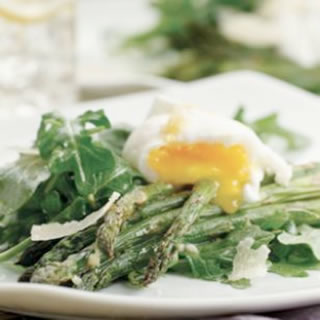News and Notes from The Johnson Center
Family and Food: Get Eggstatic Over Eggs
JCCHD | Wed, June 27, 2012 | [Family and Food][Healthcare]Humans have been eating eggs since the Neolithic age. The word “egg” comes from the Indo-European root words for “bird.” The most commonly eaten are chicken and ostrich eggs, but there are many other sources. For example, the Romans most often ate peafowl eggs. Pigeon eggs were popular in China, and the Phoenicians were partial to Ostrich eggs. Today, in both the United States and Japan, quail eggs are eaten regularly and duck eggs are increasing in popularity among European and US chefs. Other less common options include: turkey, goose, turtle, and even pelican eggs.
Eggs are associated with celebration and religion; they have been used to symbolize fertility or new life. Persian and Celtic cultures celebrated the spring equinox by giving red dyed eggs as gifts. The eggs were then shared at a meal, and finally the shells were crushed to help drive away the winter. During Lent, eggs cannot be eaten for over a month. Historically, following Lent, eggs that were saved during that time were given out to servants and children. Later, aristocrats would buy decorated eggs for loved ones. In the 19th century, the Czar of Russia’s court jeweler, Carl Fabergé, made eggs of gold, crystal, and porcelain.
Eggs are an easy way to increase the nutrition in your diet. They are a great source of protein, B12, riboflavin, vitamin D, folate, and iron, and they are a significant source of cholesterol. Cholesterol plays a key role in brain development and function, and including healthy sources of cholesterol in the diet is a wise choice for most of us. Eggs can be boiled, fried, or scrambled, and used in baking, meringues, quiches, custards, sauces, salads, and sandwiches.
Try these delicious recipes:
There is a recipe for ancient Roman eggs that is quite interesting: using medium-boiled eggs, add pepper, lovage, and soaked pine nuts. Pour on honey and vinegar; mix with garum fish sauce. Here is a modern adaptation:
Modern Egg Recipe
Ingredients:
4 medium-boiled eggs
2 ounces pine nuts
3 tablespoons vinegar
1 teaspoon honey
Pinch each of pepper and lovage (or celery leaf)
Directions:
1. Soak the pine nuts 3-4 hours beforehand in the vinegar.
2. Mix all the sauce ingredients thoroughly in a blender. This exquisite sauce should be presented in a sauce boat so that each person can serve himself or herself, since the eggs cannot be sliced and placed on a dish in advance.
http://www.pbs.org/wgbh/nova/ancient/roman-recipes.html
 Asparagus with Poached Eggs
Asparagus with Poached Eggs
Ingredients:
2 bunches asparagus (about 1 pound each), trimmed
3 tablespoons extra-virgin olive oil, divided
½ teaspoon kosher salt, divided
½ teaspoon freshly ground pepper, divided
Zest of 1 lemon
2 tablespoons lemon juice
1 tablespoon minced shallot
½ teaspoon dry mustard
4 large eggs
¼ cup distilled white vinegar
1 7-ounce bag baby arugula (about 10 cups)
½ cup shredded Daiya cheese (if desired)
Directions:
1. Preheat oven to 450°F.
2. Toss asparagus with 2 teaspoons oil and 1/4 teaspoon each salt and pepper in a large bowl. Transfer to a large rimmed baking sheet. Roast, stirring once, until very tender, 15 to 20 minutes.
3. Meanwhile, whisk the remaining 2 tablespoons plus 1 teaspoon oil, the remaining 1/4 teaspoon each salt and pepper, lemon zest, lemon juice, shallot and dry mustard in the bowl. Set aside 4 teaspoons of the dressing in a small bowl.
4. When the asparagus is done, set aside to cool while you poach the eggs.
5. Break each egg into its own small bowl. Fill a large, straight-sided skillet or Dutch oven with 2 inches of water; bring to a boil. Add vinegar. Reduce to a gentle simmer: the water should be steaming and small bubbles should come up from the bottom of the pan. Submerging the lip of each bowl into the simmering water, gently add the eggs, one at a time. Cook 4 minutes for soft set, 5 minutes for medium set and 8 minutes for hard set. Using a slotted spoon, transfer the eggs to a clean kitchen towel to drain for a minute.
6. Toss arugula with the dressing in the large bowl. Divide the salad among 4 plates. Top with asparagus and a poached egg and drizzle with 1 teaspoon of the reserved dressing. Garnish with Daiya cheese (optional).
Adapted from: http://www.eatingwell.com/recipe/asparagus_salad_poached_egg.html
Al Fresco Roasted Pepper and Chicken Sausage Frittata
Ingredients
12 oz. Chicken Sausage, thinly sliced
1 tablespoon extra virgin olive oil
3 ounces roasted red peppers, chopped
1 clove garlic, finely minced
4 large eggs
2 tablespoons fresh Italian flat parsley, chopped
½ teaspoon black pepper
½ cup Daiya (non-dairy) cheese, grated
1 teaspoon Tabasco sauce
Directions:
1. Preheat oven to 400 degrees
2. 2. Heat the oil in a 10-inch skillet over medium heat. Add the sausage and brown slightly. Add the roasted red peppers and garlic, cook for 1 minute. Reduce heat.
3. In a mixing bowl, whisk eggs. Add parsley, pepper, Daiya cheese, and Tabasco. Stir. Por egg mixture over sausage and peppers. Cook on low heat for 7-8 minutes until the bottom is set and the top is a little runny.
4. Place the skillet in the oven and cook until the eggs are set and golden brown, about 6-7 minutes.
5. When done, remove and carefully slide Frittata onto a serving platter. Slice and serve.
Adapted from: http://allrecipes.com/recipe/al-fresco-roasted-pepper-and-asiago-chicken-sausage-frittata/detail.aspx
Additional references:
http://www.eggs.ca/egg-farming/brief-history-of-eggs
http://www.foodtimeline.org/foodeggs.html



